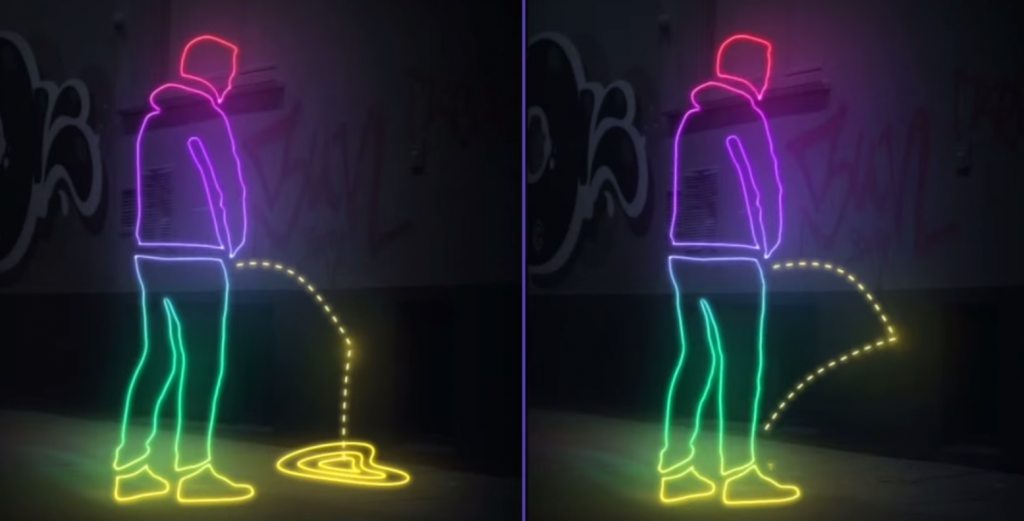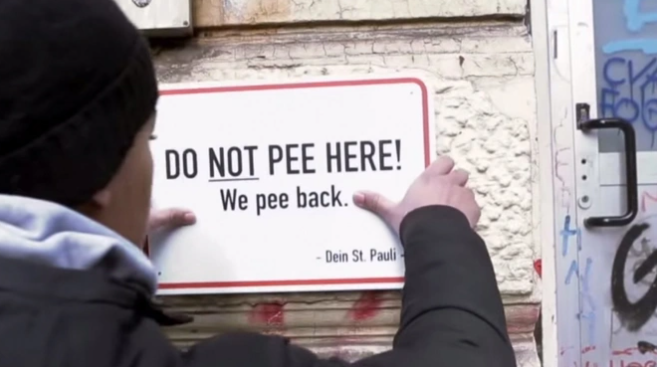It’s Peeback Time!
Hamburg, with a population of about two million people, is the second-largest city in Germany and one of the ten largest in the European Union. And like any other major European city, it has a nightlife. In the St. Pauli quarter of Hamburg is a street known as the Reeperbahn, nicknamed “die sündigste Meile” (or “the most sinful mile”) by locals. The name is well-deserved — the Reeperbahn is home to lots of bars, nightclubs, discos, and restaurants, as well as featuring some businesses that focus on erotica and topics that will place this email in your spam filter if I even mention them here.
So it should go without saying that the Reeperbahn attracts a clientele that is out late, drinks a lot, and sometimes doesn’t show great judgment. And if you visit the Reeperbahn during the day, you’ll smell evidence of that:
Many of the passageways smell a lot like pee.
But starting in 2015, the passageways started fighting back.
The problem was, really, a simple one: drunk patrons, late at night, need to empty their bladders. The vast, vast majority of them either find a restroom or wait until they get home. But sometimes, the urge to go is overwhelming (or maybe some people just suck), and, maybe clouded by the night of revelry, the men in those situations find a wall, unzip, and let it rip. Those people go home with plans on returning to the Reeperbahn another time for another night of fun, but those who live and work in the area have to deal with the stinky aftermath.
Fixing the problem wasn’t as simple, though. Public urination was already illegal and certainly, at times, a police officer was there to catch the pee-er in the act. But there are only so many cops, and it only takes a few moments to relieve oneself on a wall, so the odds of being caught in the act were low. Hamburg needed to find a deterrent that worked in the moment. The solution: hydrophobic paint, or paint that repels liquids.
This special paint, according to Forbes, is called Ultra-Ever Dry. The recipe that Ultra-Ever Dry uses for their patented paint is a secret, but as Forbes notes, you can find hydrophobic surfaces in nature, with some tree leaves being a great example. And, per Forbes, the paint probably works the same way:
When a water droplet hits the leaf, it simply can’t penetrate between the nano-bumps, and instead, the H2O molecules cling together forming a ball, that rolls off when the leaf is tilted. It sounds like the makers of Ultra-Ever Dry® have used a very similar idea to create their anti-pee wall coating. Their basecoat provides a layer with a specific chemical composition. When the topcoat is added, it interacts with these new molecules and, according to their FAQs, forms a geometric pattern of “high points” and lower regions, which together stop liquids – not just water – from sticking. It is incredibly good at doing this – a surface coated with this material actually becomes superhydrophobic, making it not just liquid-repellent, but self-cleaning.
With normal paint, as seen on the left part of the illustration (created by Hamburg) below, the malfeasor’s stream would hit the wall and run safely down to the ground, leaving him in the clear. But with the special paint, the urine hits the wall and bounces back, ruining the goer’s shoes, if not worse. (The illustration has the offender pretty far from the wall; one could imagine the drenching that would occur if he were a step closer.)

And just to make it clear that peeing on the walls was a bad idea, officials posted signs warning would-be urinators that their shoes were at risk, see seen below.

And no, not all specially-painted walls in the Reeperbahn have such signs. Many hydrophobic walls come with no warning, as to not give people a clue where it is safe to go. If you try to drain your bladder on a wall in St. Pauli, you’re playing an odd game of urinary roulette.
For the city, the paint seems to be a cost-effective solution. As of 2016, the paint cost about $100 per meter of wall space you want to cover and, because those “nano-bumps” wear down over time, it probably has to be reapplied every year. But that’s probably not a lot of money relative to the amount it costs to perpetually clean pee off of the city’s walls. The Hamburg experiment was so successful that, according to the Guardian, it “captured the attention of San Francisco officials” who then invested in their own trial. (Here’s a short video by San Francisco Public Works of the walls in action, using a water bottle and water to demonstrate.) Other cities are similarly exploring the potential of walls that pee back.
So, some words of advice for those who may feel the need late at night in an urban center: know before you go. Or even better, find a bathroom!
Bonus fact: There’s a small lizard — the Brazilian pygmy gecko — that only grows to lengths of less than an inch. As a result, it would normally not survive a rainstorm — as the BBC reports, “its diminutive size means that raindrops pose its most dangerous threat [as] the gecko could drown in a drop.” But the gecko isn’t actually worried, because its skin is hydrophobic. In fact, per that link — and there’s a video showing this, so give it a watch! — “the gecko is so small and light and its skin so water repellent it can literally stand on water.”
From the Archives: Atlanta’s Fight to Separate Elevators and Restrooms: Gross.
